Exploring Hydrofoil Boards: Mechanics and Performance
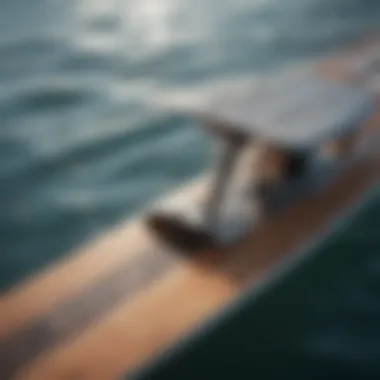
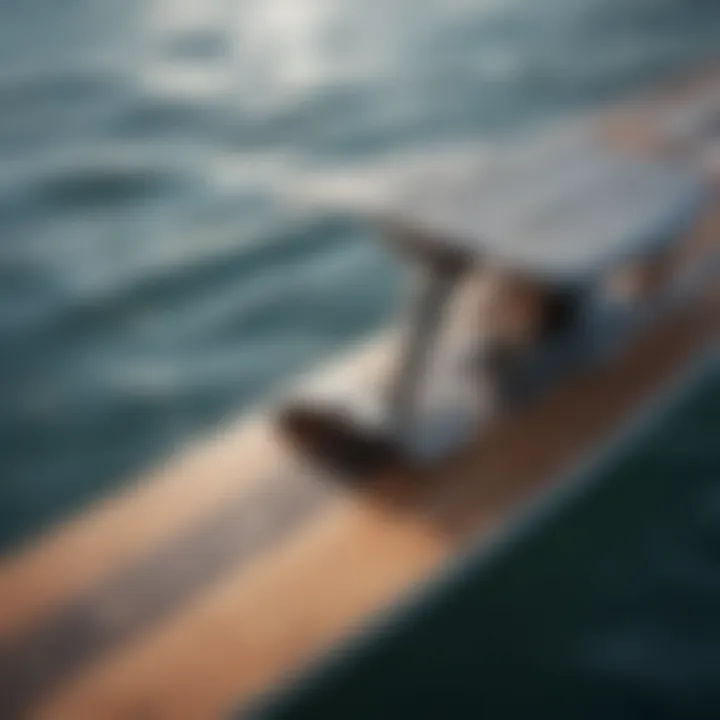
Intro
As water sports continue to evolve, hydrofoil boards have emerged as a fascinating and innovative choice for enthusiasts looking to elevate their experience on the water. Unlike traditional surfing or paddleboarding, hydrofoil boards employ a wing-like structure submerged underwater, offering riders a unique sensation of gliding above the surface. This remarkable technology has made waves not merely in surfing circles but also among kiteboarding and wakeboarding aficionados.
This article seeks to unravel the complexities of hydrofoil boards, from their design and functionality to their implications in the realm of water sports. Whether you’re a novice eager to skim the surface or a seasoned pro looking to refine your technique, understanding the mechanics behind hydrofoiling is crucial. Armed with this knowledge, one can fully appreciate how these boards have redefined the parameters of water-based recreation.
Techniques and Skills
Navigating the waters on a hydrofoil board requires not just courage but also a set of finely honed techniques. It’s essential to grasp the fundamental methods first before advancing to more intricate maneuvers.
Fundamental Techniques for Beginners
- Stance and Balance: Maintaining a solid stance is the cornerstone of mastering hydrofoiling. Distributing your weight evenly between your feet helps in achieving balance and preventing spills.
- Starting Position: As you begin, position yourself on the board with your front foot placed over the foil. This positioning will stabilize you as you rise.
- Gradual Acceleration: Start with a slow pace, gradually increasing your speed as you gain confidence. Too much speed too soon can lead to instability.
- Body Positioning: Leaning slightly forward helps in lifting the board off the water. Your hips should align over the foil for better control.
Practice consistently, and don’t be disheartened by initial challenges. It’s all part of the learning curve.
Advanced Skills for Experienced Athletes
Once comfortable with the basics, experienced hydrofoilers can delve into more advanced skills that demonstrate control and finesse on the board:
- Carving Turns: Experiment with shifting weight to initiate smooth curves. Effective turns require precise control of your body balance.
- Jumping: Timing is vital. As you approach a wave, compress your knees slightly, then push off with enthusiasm to pop into the air.
- Race Techniques: For those interested in competition, mastering drafting and optimizing your stance for speed will be crucial. Practicing in various conditions will prepare you for race day.
"To soar on a hydrofoil is not merely to ride; it’s to orchestrate a delicate ballet between balance and speed."
Safety and Gear
Engaging in hydrofoiling without proper safety measures can be a recipe for disaster. Understanding essential safety practices is an integral part of the experience.
Essential Safety Measures in Watersports
- Wear a Life Jacket: This is a must, even for the most skilled riders. Accidents can happen, and buoyancy aids are crucial.
- Helmet and Impact Vest: Protecting your head and torso can prevent serious injury during falls.
- Know Your Terrain: Always familiarize yourself with the body of water. Watch out for other watercraft, shallow areas, and currents.
- Check Weather Conditions: Ensure that conditions are suitable. Wind and wave height can drastically influence safety.
Gear Reviews and Recommendations
To fully embark on your hydrofoiling journey, high-quality gear is essential. Here are a few recommendations:
- Boards: Look into models from brands like Naish, Slingshot, and Liquid Force. Their designs cater to both beginners and advanced foilers.
- Foils: The choice of foil can affect your experience. Brands like Armstrong and Lift offer adaptable models that suit various conditions and styles.
- Safety Gear: A good life jacket and helmet are indispensable—brands like ProLimit and C-Skins are often celebrated for their reliability and comfort.
With the right preparation and knowledge, hydrofoiling can be nothing short of exhilarating. As technology advances and designs evolve, it's an exciting time to be involved in this innovative watersport.
Preamble to Hydrofoil Boards
Hydrofoil boards represent a transformative development in water sports, differentiating themselves from traditional boards through their innovative design and mechanics. This section aims to shed light on the significance of hydrofoiling, emphasizing its appeal to a variety of water sports enthusiasts and outdoor adventurers. By understanding the nuances of hydrofoil boards, one can appreciate the intricacies involved in their operation and the benefits they offer.
A hydrofoil board consists of a board mounted with a foil that extends below the waterline. This set-up enables the rider to lift above the water's surface, resulting in a smoother ride with reduced drag. The crucial element of this design is its capability to slice through water with remarkable efficiency—think of it like flying just above a hard surface instead of trudging through mud.
Benefits of Hydrofoil Boards
The advantages of hydrofoil boards can be summed up in a few key points:
- Increased Speed: Once in motion, hydrofoil boards glide seamlessly through water. This speed can be exhilarating and provides a distinct advantage in competitive scenarios.
- Smooth Ride: The lack of direct contact with surface waves leads to an experience that feels less turbulent than traditional boards.
- Versatility: Hydrofoiling is not limited to one type of board. The designs cater to various sports such as surfing, kiteboarding, and paddleboarding, making them inclusive for a broader audience.
However, it's not all sunshine and rainbows. There are considerations to keep in mind about hydrofoiling, especially for novices. The learning curve can be steep for beginners, as mastering the balance and coordination required is no small feat. Thus, recognizing the challenges along with the perks is vital for prospective users.
"Hydrofoiling isn't just a trend; it's a redefinition of what water sports can be."
In this context, it becomes essential to explore the roots and evolution of hydrofoil technology, which brings us to the next layer of understanding this fascinating equipment.
Defining Hydrofoiling
At its core, hydrofoiling is a technique that allows boards to ascend above the water, utilizing a hydrofoil—a wing-shaped structure submerged underwater that generates lift. This lift propels the board and rider upward, significantly reducing water resistance. The concept of lift is central to the performance of hydrofoil boards, relying on Bernoulli's principle, where faster-moving fluid results in lower pressure. As the rider accelerates, the foil moves through the water, creating uplift that defies the pull of gravity, achieving the state of an airborne ride. Hydrofoiling is not just about being above the water, it's an experience that allows for creative maneuvers and unique styles.
Historical Development
The journey of hydrofoil technology traces back to the early 1900s, when engineer and inventor Alexander Graham Bell pioneered the first designs primarily for aircraft. Fast forward a few decades to the 1960s, where hydrofoil technology found its way into the marine realm thanks to innovators like Bob Woodward and his team, who developed hydrofoil boats.
Though initially considered as toys for the rich, the sport evolved gradually. By the 1990s, hydrofoils started to gain popularity in the realm of kitesurfing, wherein users adapted traditional kiteboarding equipment with hydrofoil systems, leading to a wave of enthusiasts who sought the thrill of gliding above the water.
Today's hydrofoil boards are a product of refined engineering, combining artistry with rigorous testing to optimize performance, design, and rider experience. The sporting world now recognizes hydrofoil boards not just for their novelty but as a game-changer in water sports, exemplifying the marriage of technology and adventure.
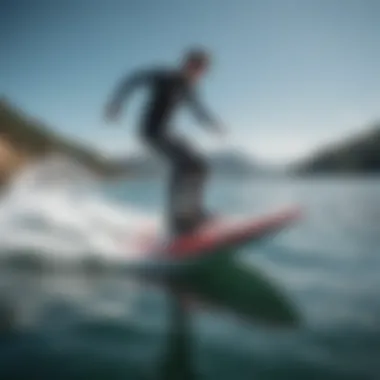
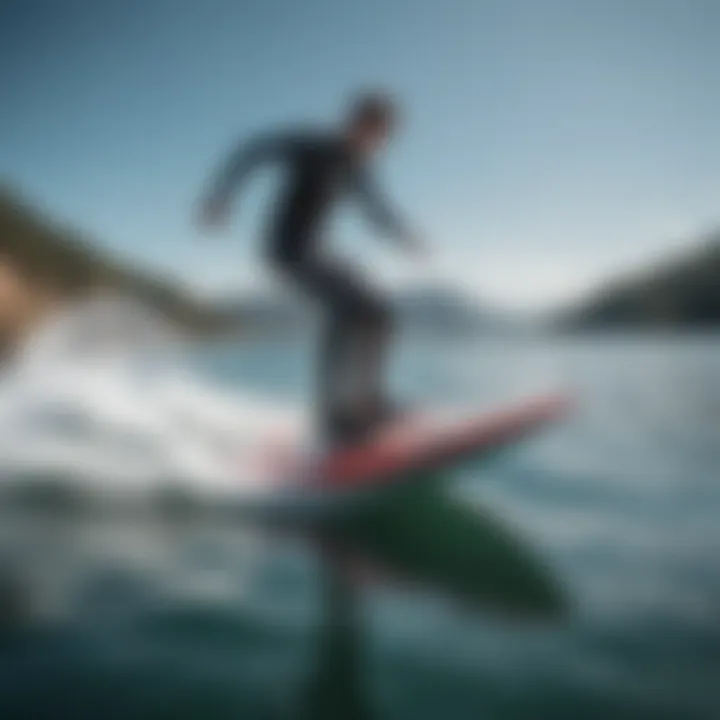
Mechanics of Hydrofoil Boards
Understanding the mechanics of hydrofoil boards is key to unlocking their full potential on water. It’s not just about floating on the surface; it’s about feeling the synergy between board and water, which leads to exhilarating rides. Hydrofoiling allows surfers, kiteboarders, and wakeboarders to glide above the water with minimal drag. This frees riders from the limitations of traditional water sports, creating opportunities for speed and agility that previously were only dreams.
Understanding the Foil System
At the heart of hydrofoil boards is the foil system. This system typically consists of a mast, wings, and a fuselage. The mast connects the board to the wings, which are submerged in the water. When a rider gains enough speed, the wings generate lift, elevating the board above the surface. This reduction in drag allows for seamless fluid motion, promoting a smooth ride even in choppy conditions.
Understanding how this lift is achieved is crucial. The wings are designed to alter pressure differently on their top and bottom surfaces. This pressure difference results in lift during forward motion. An interesting aspect is that even a tiny increase in speed can dramatically enhance lift, sometimes making it feel as if the board is almost floating.
Foil Design Variations
When it comes to foil design, not all wings are created equal. Variations in wing shape, size, and aspect ratio cater to different riding styles and conditions. For instance,
- High Aspect Wings: These offer less drag and are ideal for speed, working well for racers and those seeking high velocity.
- Low Aspect Wings: These provide increased stability, making them suitable for beginners and casual riders.
- Wide Wings: Wider designs deliver better lift at lower speeds, appealing for foiling in smaller waves.
Riders often experiment with different designs to find what complements their style, much like a musician tweaking their instrument. Each variation offers a distinct feel and responsiveness, which can make or break the experience on the water.
Material Considerations
Material choice in hydrofoil construction significantly impacts performance and durability. Typical materials include carbon fiber, aluminum, and fiberglass.
- Carbon Fiber: Provides a perfect balance of strength and weight, making it a top choice for high-performance boards.
- Aluminum: While heavier, it offers increased resistance to dents and is generally more cost-effective.
- Fiberglass: Often used in entry-level foils, it offers durability and is easy to repair but may not perform as efficiently at higher speeds.
Choosing the right material depends on personal preference and intended use. Riders must evaluate factors like budget, performance needs, and longevity of the equipment.
"The right material can shape the entire experience of hydrofoiling, influencing everything from speed to maneuverability."
Overall, the mechanics of hydrofoil boards—through the understanding of the foil system, design variations, and material considerations—represent a vast field of exploration for enthusiasts. The intricate balance of these elements not only enhances performance but creates a dynamic connection between rider and water, reinforcing why many are gravitating towards this exhilarating sport.
For further reading on hydrofoiling, you can check resources like Wikipedia and Britannica.
Types of Hydrofoil Boards
Understanding the various types of hydrofoil boards is crucial for enthusiasts looking to engage with the sport on a deeper level. Each type of hydrofoil board caters to different water conditions, riding styles, and performance preferences. Selecting the right board can enhance a rider's experience, contributing to both skill development and enjoyment on the water. By delving into the specific attributes and functionalities of each type, readers can make informed choices that align with their individual interests and capabilities.
Surf Foils
Surf foils are designed with the surfer in mind, allowing for a unique riding experience that marries the art of traditional surfing with the thrill of hydrofoiling. These boards typically feature shorter wings that provide quick lift and are streamlined to allow for rapid maneuverability. With surf foils, riders can catch smaller waves, drawing them into the swell while elevating above the surface, offering a sensation akin to flying.
One key advantage is that surf foils can perform exceptionally well in choppy conditions. The ability to glide over rough waters opens up a world of possibilities, transforming a mundane day at the beach into an exhilarating adventure. However, mastery requires practice as balancing on a surf foil demands precision. Riders looking to dive into the world of surf foiling must also take note of local wave conditions and choose their board size accordingly.
Kite Foils
Kite foils are a game-changer in the kiteboarding community. They allow riders to harness the power of the wind while floating above the water. Kite foiling boards are often wider and longer compared to their counterparts, which grants greater stability. Furthermore, the foils attached to these boards typically have a larger surface area to lift the board, providing efficient speed with minimal drag.
The main appeal of kite foils lies in their ability to reach impressive speeds while maintaining control, even in less than ideal wind conditions. Riders can also enjoy the thrill of upwind riding, which makes long-distance kite foiling possible. A word of caution: newcomers should approach kite foiling with a learning mindset, as coordinating between the kite and the foil board can prove to be a steep learning curve.
Wake Foils
Wake foils are specifically crafted for connecting with the wakes produced by boats. These boards are shorter and provide a stable platform for riders to launch into the air or carve through the wake. Unlike other types of hydrofoil boards, wake foils have a more forgiving design, allowing for easier entry into the sport.
Riders often benefit from wake foiling in terms of speed and tricks, with many using it for aerial maneuvers that are difficult to achieve on traditional wakeboards. The thrill comes not just from catching the wake, but also from the enhanced sense of freedom and agility it provides. However, riders must consider their boat's wake shape and size to fully enjoy the potential that wake foiling offers.
Wind Foils
Wind foils cater to those who enjoy windsurfing but crave a different level of excitement. Debuting as a modern evolution of traditional windsurfing, wind foils employ a hydrofoil to lift the sailor above the water's surface, reducing drag. They often incorporate a longer mast to ensure smooth passage over choppy waters.
One of the clear benefits of wind foiling is the reduced impact of waves on the rider's experience. This makes for a more enjoyable ride, especially in rough conditions. That said, wind foiling also requires a slightly different approach in terms of technique and handling. Although the learning curve exists, many find the transition rewarding as it allows for a unique connection with the wind and water.
As the world of hydrofoiling continues to expand, each type offers unique advantages, making it essential for riders to discover what aligns with their individual interests, so they can truly enjoy the sport to the fullest.
Performance Analysis
When discussing hydrofoil boards, performance analysis stands at the forefront. The nature of this water sport inherently revolves around how well a board performs in various conditions. It touches on elements like speed, agility, stability, and control, which are critical for both novice and advanced users. Performance is not just a metric of joyride but also a vital consideration for safety and practical use in diverse water environments.
Speed and Agility
Speed is often a primary draw for many hydrofoil enthusiasts. The thrill of slicing through water, experiencing a rush unlike any other, is what catches many to this sport. A hydrofoil board’s design significantly influences its speed. For instance, deeper and more varied wing shapes allow for more efficient lift, resulting in quicker planing across the water's surface.
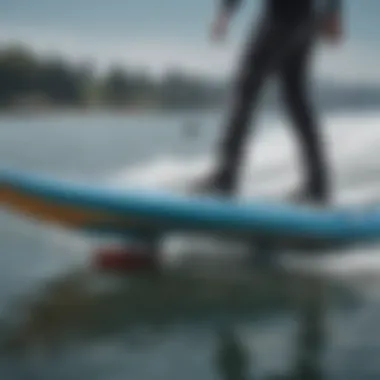
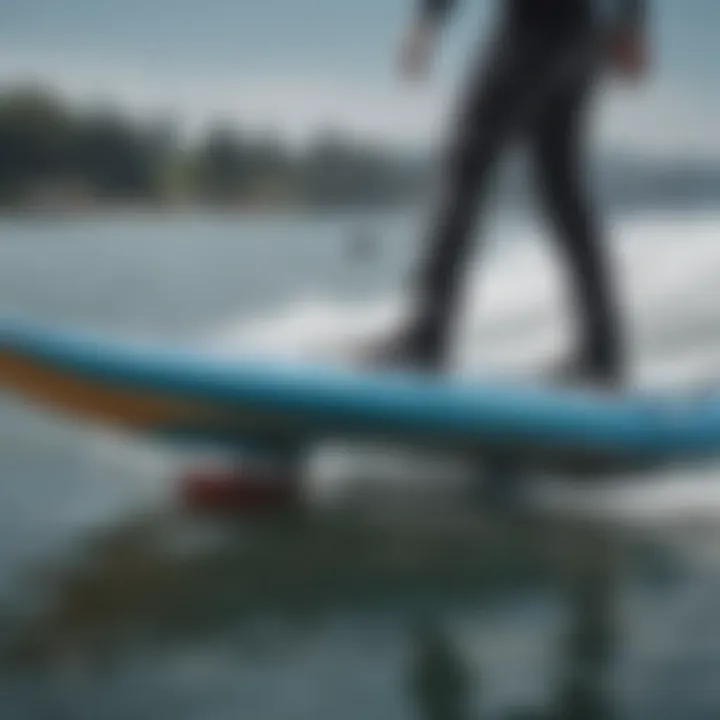
Agility, conversely, refers to how well a rider can navigate through turns and adjusts to sudden changes. A well-designed hydrofoil board provides responsive handling, which is essential when riding over waves or in wind. Consider boards like the Lift Foils that emphasize fluid dynamics in their engineering, enabling quicker transitions and smoother maneuvers.
Some key factors enhancing speed and agility include:
- Wing Shape: Influences lift and drag.
- Board Size: A narrower board can be faster but may sacrifice stability.
- Rider Positioning: Where you stand impacts balance and speed.
Stability and Control
With great speed comes the need for stability. Stability is critical, particularly during sudden turns or in choppy water conditions. A hydrofoil board needs to maintain its altitude above the water while allowing slight adjustments. Boards designed with wider wings tend to provide better stability, ensuring less wobbling, which can be crucial during high-speed rides.
Control also plays a vital role. A rider should feel confident in managing the board's movements. Stability coupled with good control allows for more daring tricks and skills to be executed effectively. Boards like the Slingshot Hover Glide embody this concept with a well-thought-out system that balances lift with responsive steering capability.
To enhance stability and control:
- Weight Distribution: Positioning your weight correctly can influence how stable you feel.
- Foil Angle: The angle of attack greatly affects lift and drag.
- Riding Conditions: Choosing the right conditions for your skill level enables better control.
Learning Curve and Skill Development
Hydrofoiling isn't just about jumping on a board and taking off; there's a notable learning curve involved. Mastering the balance between lift, weight positioning, and board control takes time. Many new riders find the adjustment challenging, initially struggling to get up on the foil or maintain speed without dropping back into the water.
As riders invest time in practice, they develop essential skills like:
- Balance: Finding the sweet spot on the board enhances control.
- Timing and Coordination: Knowing when to push against the lift helps maintain flight.
- Visual Awareness: Observing water conditions and adjusting techniques accordingly.
Tips for overcoming the learning curve:
- Start on a board with large wings, which provides more lift and stability.
- Practice on calm days to build confidence before tackling waves.
- Leverage lessons from experienced riders or instructional videos for tips on technique.
"Mastery comes with patience; each failed attempt teaches us more than success ever could."
Safety Considerations
When engaging in the exhilarating world of hydrofoil boarding, prioritizing safety is key. This adventurous sport, while thrilling, comes with its unique set of challenges that necessitate a distinct approach to keeping enthusiasts out of harm’s way. Understanding safety measures is crucial not only for individual well-being but also for fostering a responsible community of riders who respect the aquatic environment.
Essential Safety Gear
Equipping oneself with the right safety gear can significantly improve a rider’s experience on the water. Here’s a closer look at the indispensable items every hydrofoil enthusiast should consider:
- Helmet: A sturdy helmet designed specifically for watersports is fundamental. It protects against head injuries from falls or collisions.
- Impact Vest: An impact vest provides cushioning and buoyancy. It shields the chest and back while aiding flotation, especially valuable when learning or practicing maneuvers.
- Wetsuit: Depending on water temperature, a wetsuit can help regulate body heat. It also offers some padding and resistance from cuts and scrapes.
- Leash: A reliable leash connects the rider to the board, preventing it from drifting away during a wipeout and ensuring easier retrieval.
- Fins or Foot Straps: These keep the feet secure on the board, improving balance and reducing the risk of accidents caused by slipping off during high speeds.
Wearing this gear doesn’t merely comply with safety guidelines; it can make the difference between a thrilling ride and a potentially dangerous situation.
Common Risks and How to Mitigate Them
Every sport comes with risks, and hydrofoiling is no exception. Understanding common hazards can help riders prepare and make safer choices:
- Collisions with Obstacles: Riders can easily collide with stationary objects, other surfers, or even swimmers. To avoid this, always be cognizant of your surroundings. Keep an eye on the proximity of others and signal before performing maneuvers.
- Falls: Falling is par for the course, especially for beginners. The key is to learn how to fall safely. Keeping limbs relaxed can help minimize injuries upon impact with the water or the board. Practicing proper technique can also reduce the chances of falling altogether.
- Water Conditions: Unpredictable water conditions like high waves or strong currents can pose risks. It's advisable to check weather and tide reports before setting out. If conditions look rough, perhaps consider another day for hydrofoiling.
- Drowning Risks: While a good safety vest provides flotation, it’s prudent to remain aware of one’s limitations. Beginners should consider learning in shallow areas. It’s beneficial to have someone with you who can assist in emergencies.
"Taking proactive steps towards safety enhances not just your ride but the enjoyment of those around you too."
By being mindful of these risks and having appropriate mitigation strategies in place, hydrofoil boarders can ensure that adventure and safety go hand in hand, allowing for the thrilling depth of this sport to be experienced with a clear mind.
Being equipped, informed, and aware will not only boost confidence but will also encourage a culture of safety in this vibrant community.
The Environmental Impact of Hydrofoil Boards
Understanding the environmental footprint of hydrofoil boards is essential as the sport grows. Water enthusiasts are becoming more conscious of how their activities impact oceans, lakes, and rivers, highlighting the importance of responsible use. Hydrofoils are perceived as a playful escape into nature, yet their production, usage, and disposal intertwine with ecological concerns.
As you gleam insights from this part of the article, it becomes crystal clear that evaluating the sustainability of materials and the effects on marine ecosystems is paramount for those who are passionate about preserving the beauty of our waterways.
Sustainability of Materials
When discussing the sustainability of materials, the conversation often starts with the types of substances used in the construction of hydrofoil boards. Generally, most boards are made from plastic, foam, and carbon fiber.
- Carbon Fiber: While strong and lightweight, its production process is energy-intensive and often releases harmful emissions. However, recent advances have led to the development of more eco-friendly alternatives.
- Foams: Many boards still use traditional polyurethane foams which are not biodegradable. However, newer biodegradable options are emerging on the market, aiming to lessen this burden.
- Recycled Plastics: There's a growing trend in using recycled plastics for certain components, promoting the principle of circular economy in sports equipment.
"Each time we choose environmentally responsible materials, we play a role in safeguarding our waters."
For water sports aficionados, embracing sustainable choices not only enhances performance but also contributes to conservation efforts. Selecting products that emphasize eco-friendliness is more than just trendy; it reflects an awareness of the impact every new board has on the environment.


Effects on Marine Life
Next up, let’s look closely at how hydrofoil boards influence marine ecosystems. While enjoying the water, it's crucial to keep in mind the often-overlooked creatures that call it home.
Hydrofoil operations, especially in busy waterways, can disturb aquatic life, particularly during the breeding seasons for fish and other wildlife.
Key points to ponder include:
- Noise Pollution: The sounds generated from the boards can disrupt natural behaviors of marine animals, affecting their ability to communicate, feed, and breed.
- Physical Displacement: As boards glide through water, they can inadvertently push fish and other creatures away from their habitats.
- Pollution: The potential for leaking oils or fuels from mechanical parts, though rare, can create risks for delicate ecosystems.
The eco-conscious rider should be aware of where they ride, opting for areas less frequented by wildlife, or at times when disruption is minimal. Balanced participation in water sports can lead to both fun and care for the ocean.
Ultimately, hydrofoil boards introduce a thrilling dimension to water sports, yet practitioners must always think about their footprint. By selecting more sustainable materials and practicing respectful riding, one can enjoy hydrofoiling while being guardians of the environment.
Competitive Scene
The competitive scene surrounding hydrofoil boards has burgeoned, offering a fascinating glimpse into the sport's exhilarating nature. As more enthusiasts take the plunge, competitions have sprung up, fostering a sense of community and pushing the advancement of skills and technology in hydrofoiling. This rising interest is not merely about racing or performing tricks but establishing a structured ecosystem that celebrates innovation, athleticism, and environmental awareness.
In this context, competitions hold several benefits. They serve as platforms for showcasing talent and ingenuity, allowing riders to express individual styles while testing their limits against others. The camaraderie builds bonds among participants, creating an enduring network among recreational users and professional athletes alike. Moreover, the competitive aspect propels manufacturers to refine their products, leading to a cycle of improvement in material technology, design, and overall performance.
International Competitions
International competitions have emerged as the gold standard for hydrofoil enthusiasts. Events such as the Hydrofoil World Championships draw participants from diverse backgrounds, bringing together a mix of seasoned pros and ambitious amateurs. These contests not only highlight incredible skills but also underscore the evolving nature of this sport which is finding its way into global watersports festivals.
At these events, competitors are judged on various criteria, typically measuring speed, control, and creativity. For instance, the performance in different conditions—be it flat water or choppy seas—adds layers to the competition’s challenge. Additionally, formats can vary, with some events emphasizing freestyle performances while others may focus on slalom racing. The adrenaline rush and sheer excitement witnessed during these events tantalize audiences, turning the obscure into the mainstream.
Regulatory Organizations
To maintain fairness and safety in the sport, various regulatory organizations have sprung up. These bodies set the rules and guidelines that govern competitions to ensure that safety standards are upheld without stifling innovation. For example, organizations like the International Kiteboarding Association play a vital role in establishing equipment regulations and competition formats.
Having a structured set of regulations also serves a deeper purpose. It helps in facilitating international participation while reassuring newcomers that their interests are protected. Furthermore, regulatory frameworks address environmental considerations, urging event organizers to adopt sustainable practices.
"When the wind is at your back and the thrill of competition is in your veins, hydrofoiling takes on a whole new meaning."
The Future of Hydrofoil Technology
As the watersport landscape continues to evolve, the future of hydrofoil technology stands as a beacon for innovation and progression. With advancements at our fingertips, hydrofoil boards are not just mere equipments but pivotal pieces that can redefine how watersports enthusiasts experience the great outdoors. Understanding the future implications of hydrofoil technology guides us in appreciating the possibilities it offers.
Innovations on the Horizon
The realm of hydrofoiling is undergoing transformational changes, spearheaded by both tech enthusiasts and seasoned riders eager to push boundaries. One of the most exciting developments is the integration of smart technology into hydrofoil boards. Imagine a board that adjusts dynamically to changing sea conditions, utilizing sensors to provide real-time feedback on performance and stability. This innovation could enhance safety while providing a tailored riding experience.
In addition, we’re seeing a rise in eco-friendly materials. Companies are increasingly focused on sustainability, aiming for designs that minimize environmental impacts. This includes utilizing recycled composites and bio-based materials, which not only reduce the carbon footprint but also appeal to eco-conscious consumers. Moreover, improvements in manufacturing techniques promise lighter, stronger boards that maintain high performance, allowing riders to achieve new levels of speed and agility.
- Smart Technology Integration: Sensors for real-time feedback, adjusting to conditions.
- Eco-friendly Materials: Recycled composites and bio-materials for a sustainable future.
- Advanced Manufacturing: Lighter and stronger boards that beat performance records.
Evolving Use Cases
As we peer into the crystal ball of hydrofoiling, it's clear that versatility is key. Hydrofoil technology is not merely confined to traditional settings; it is rapidly expanding into various domains. New applications are popping up all over the place. For starters, hydrofoil boards are becoming a favored tool in fishing. Imagine standing easily atop the water, quietly cruising over currents while you cast your line. This offers fishermen a unique vantage point and access to hard-to-reach areas, truly revolutionizing the angling experience.
Another fascinating avenue is the blend of hydrofoiling with fitness. Hydrofoil yoga classes are gaining traction, allowing practitioners to engage in mindfulness on water while incorporating balance and core strength training. Moreover, assisted hydrofoiling has emerged. With the advent of electric motors, beginners can experience the thrill of foiling without the steep learning curve. This opens doors for more people to enter the sport.
- Fishing Applications: Ideal for reaching otherwise inaccessible spots.
- Fitness and Wellness: Hydrofoil yoga blends strength and balance on water.
- Assisted Hydrofoiling: Electric motors making the experience accessible to newcomers.
The future of hydrofoil technology is not just about riding the waves. It's about adaptability, sustainability, and broadening access to a beloved sport.
Ending
The conclusion of this article serves as a vital capstone, bringing together the myriad elements that define hydrofoil boards. Understanding hydrofoils isn't just about their mechanics but also appreciating how they fit into the larger picture of water sports. This equipment continues to change the game, inviting both enthusiasts and newcomers into its serene, yet exhilarating waters.
Summary of Key Insights
In summation, it is clear that hydrofoil boards are not simply a passing trend. They represent a fusion of engineering and athleticism that enhances water sports profoundly. Key insights from this exploration include:
- Unique Design: The shape and materials used in hydrofoil boards allow for a smoother ride, improving performance across various water conditions.
- Versatility: With applications in surfing, kiteboarding, and more, these boards cater to a wide audience. The customizability of different foil types means that each rider can find their perfect setup.
- Performance Benefits: The lift generated by the hydrofoil significantly increases speed while minimizing drag, empowering users to glide above the water, which enhances the overall experience.
- Environmental Considerations: Adoption of sustainable materials and awareness of ecological impacts plays a role in shaping future production and usage.
- Safety and Regulations: Learning about essential safety gear cannot be overlooked. Knowledge of local regulations ensures respectful use of both equipment and environment.
Ultimately, the insights gathered illustrate not only the technical prowess of hydrofoil boards but also their potential to invigorate the sports community. As technology and design evolve, they will undoubtedly continue to enhance user experiences.
The Appeal of Hydrofoiling
The allure of hydrofoiling goes beyond just riding a board; it embodies a lifestyle and a connection to the water. For many, the thrill of overcoming the elements and finding balance on the water is unparalleled. Reasons for this deep-seated appeal include:
- Elevated Sensation: The experience of riding above the surface is often likened to flying. Such a unique perspective can dramatically change how individuals view their surroundings.
- Challenging and Rewarding: Riders often find a profound sense of achievement as they learn to control their boards, turning a challenging endeavor into a rewarding hobby or sport.
- Community and Camaraderie: There’s a strong community of hydrofoil enthusiasts fostering connections through shared experiences and knowledge. Joining this group offers camaraderie that deepens the appeal of the sport.
- Evolving Opportunities: Innovations are regularly emerging, expanding possibilities not just for seasoned riders but also for complet novices.
In essence, hydrofoiling taps into fundamental human desires—freedom, adventure, and exploration. It reaches the core of what it means to engage with nature through sport, offering incredible memories and experiences that resonate far beyond mere recreation. As we close this discussion, the future could hold even more exciting developments—pushing boundaries and enhancing our relationships with water sports.















